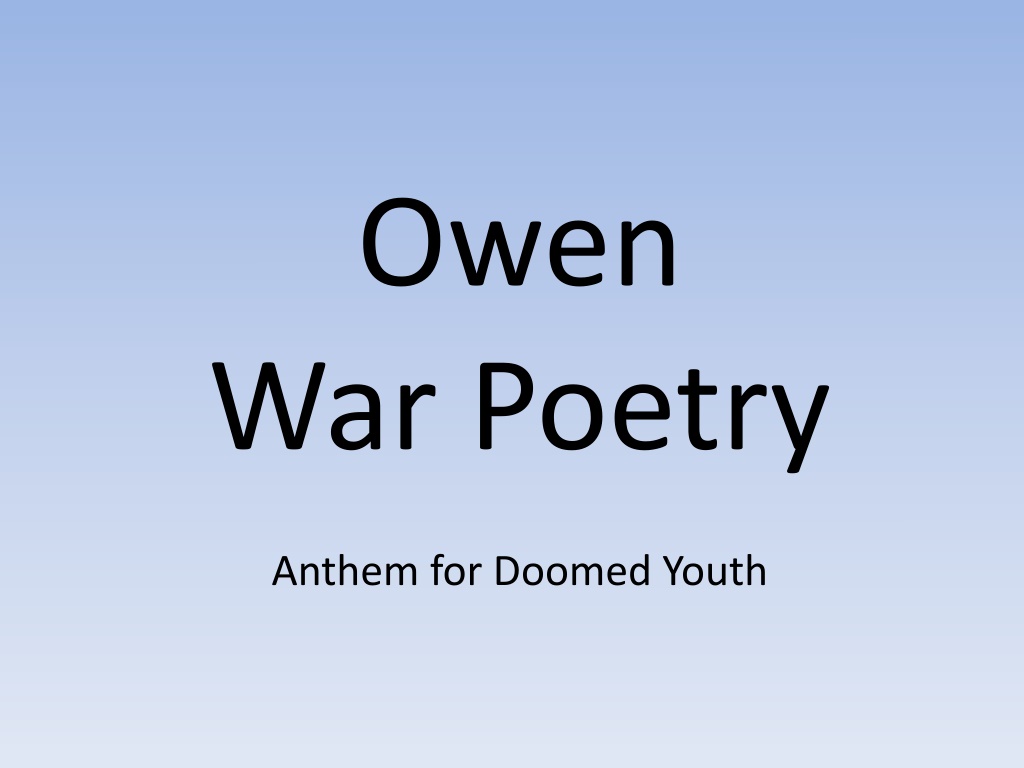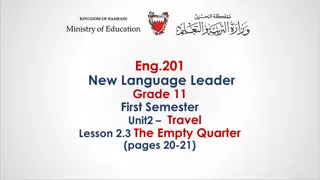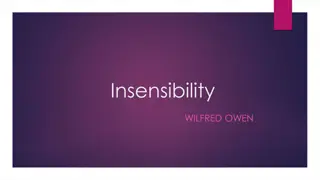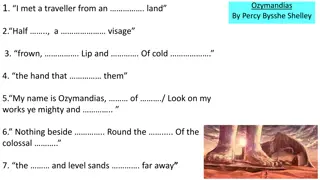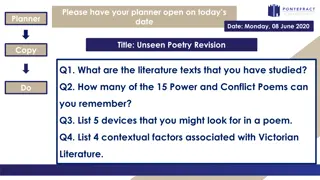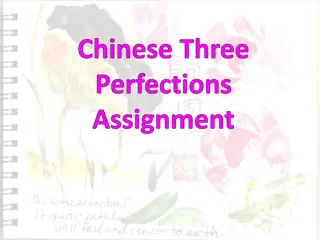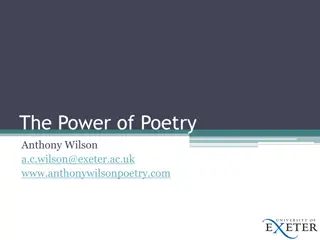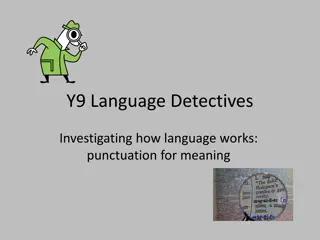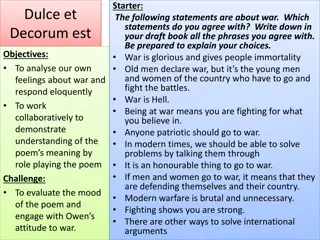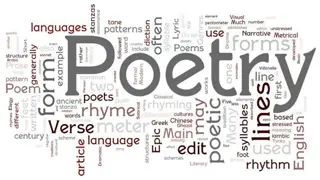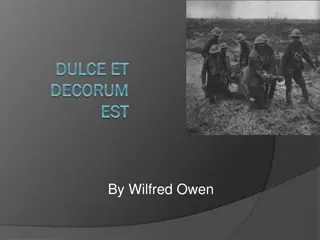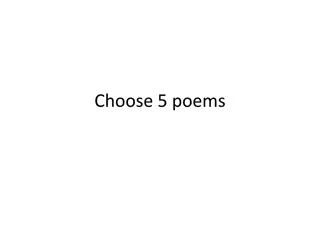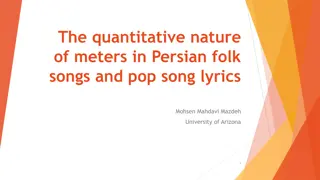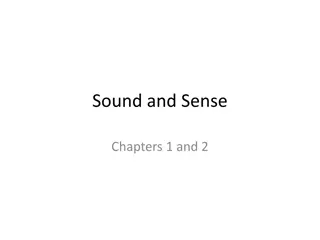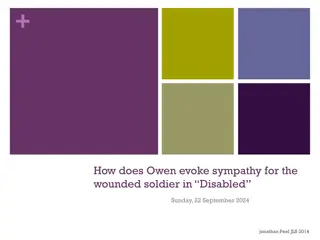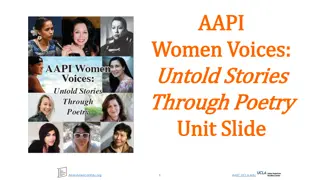Exploring the Poetry and Life of Wilfred Owen
Delve into the profound journey of poet Wilfred Owen, from his dreams of Romanticism to the harsh realities of war. Encounter his mental struggles, collaborations with Siegfried Sassoon, and the deep-seated themes of religion, death, and nature in his works. Uncover the powerful impact of Owen's experiences on his poetic expressions, shedding light on the context, obsessions, and significant moments that shaped his artistry.
Download Presentation

Please find below an Image/Link to download the presentation.
The content on the website is provided AS IS for your information and personal use only. It may not be sold, licensed, or shared on other websites without obtaining consent from the author.If you encounter any issues during the download, it is possible that the publisher has removed the file from their server.
You are allowed to download the files provided on this website for personal or commercial use, subject to the condition that they are used lawfully. All files are the property of their respective owners.
The content on the website is provided AS IS for your information and personal use only. It may not be sold, licensed, or shared on other websites without obtaining consent from the author.
E N D
Presentation Transcript
Owen War Poetry Anthem for Doomed Youth
Starter activities 1. What anthem (representative song) should there be for today s teenagers? Eg choose a suitable pop/hip-hop song? Why choose it? 2. How would you describe teenagers today? Lost? Happy? Worried? Anxious? What adjective would you choose? 3. What songs are suitable for funerals? 4. What songs/noises/things would you definitely think wouldn t be good?
Learning Intentions To learn about how and why a poet uses extended metaphors in his poems. To learn about the contexts of Wilfred Owen s poetry. To learn how a poet creates a atmosphere of horror and pity
The Context of the poem This was the break-through poem for Wilfred Owen. At the beginning of the war, Owen dreamed of being a Romantic poet. He was teaching in France and returned to enlist in 1915. After training in Romford in 1916, he was sent out to the front in the new year. He was only a few months on the front but it shook him to the core: he captured a German dug-out, saw men die horribly and one go blind from gas (see The Sentry and Dulce Et Decorum)
Meeting Sassoon Owen was put in a mental hospital in Edinburgh, Scotland called Craiglockhart. It was an enlightened place. There he met Siegfried Sassoon, a famous poet who d been put in the mental hospital for protesting against the war. Sassoon and Owen s psychiatrist encouraged him to start writing poetry again. Until then Owen s poetry had mainly been very romantic , all about nature
Owens obsessions Religion. His mother, who he was devoted to, was very religious, but Owen rejected religion after a bad experience as an assistant to a Vicar in Oxford before the war. A double funeral of a mother and her four-year-old daughter shook him to the core. Death. Nature. Young men. Owen was almost certainly gay as was Sassoon. Poetry. The music and texture of words
What do you think the content of the poem will be? What words from the poem do you think are most significant?
Wilfred Owen One of his most famous poems is called Task - in pairs: What do these words mean? What do you think the poem is going to be about? Ext: Why do you think he chose them? Anthem for doomed youth
Read the first stanza (paragraph) in your groups and try to work out what you think the poem is about. How would you summarise the message?
Difficult vocabulary Notes for students Anthem:1. A rousing or uplifting song identified with a particular group, body, or cause. 2. A song officially adopted by a country as an expression of national identity. Passing-bells: a bell rung to announce a death or funeral. Hasty: quick, hurried Orisons: prayers Choirs: note the connection to Keats To Autumn, l.27: Then in wailful choice the small gnats mourn
Difficult vocabulary Mockeries: Owen had been religious but now felt religion was a mockery of life and felt the ceremonies of religious (prayers, bells, choirs) were mockeries of life. Demented = completely mad Bugles = wind instruments played at funerals or solemn occasions Shires = country districts. Millions of young men from the country died in the 1st WW.
Difficult Vocabulary Speed them all = Help them go quickly to heaven. Pallor: Pale colour Pall: A cloth spread over a coffin, hearse, or tomb. Line 14 Binyon s For The Fallen is important here: At the going down of the sun and in the morning/We will remember them. The drawing of blinds in a house was common when there had been a death
Sounds 1. Before we look in detail at this difficult poem, underline all the sounds in it! 2. Can you guess what it s about? Try your hardest! BIG POINT: the poem makes a long comparison between WHAT should be the song for our young people, and WHAT is. The poem is as much about what is NOT happening as what IS happening. What is not happening?
Key things to know about a poem What it is about you must understand it fully What techniques a poet uses to achieve certain effects The possible contexts of a poem
An Elegy This poem is a lament for the dead Why is the youth doomed ? Doomed to die; doomed to madness; doomed to unhappiness
Structure and Form This poem takes the form of a sonnet usually love poems or with a religious focus. What parts of the poem focus upon religious issues and what parts suggest love? What is the main topic of the poem? Sonnets often have the structure of having eight lines (the octet) where the main point is set out, and then six lines which conclude the poem (the sestet). Is this the case here?
Context This poem was written in a mental hospital for shell-shock victims, Craiglockhart, Edinburgh, in Sept-Oct 1917. Siegfried Sassoon helped a lot with the composition of the poem. What clues are there in the poem that it s written by someone very disillusioned by the war? Is this poem patriotic ? Where do the poet s sympathies lie?
The Pity of war Owen sgreat theme was the pity of war . What images suggest the pity of war in this poem and why?
Tasks Read the annotated poem Highlight the techniques and key points Add notes about any details you think have not been picked out in annotated poems: e.g. what the poem is about; the different techniques the poet uses and WHY he uses them; speculate about WHY he might have written the poem; note down your PERSONAL responses, your thoughts and feelings.
Questions about meaning and poetic effects 1. Think of three questions to ask about the poem yourself 2. Line 1: what is the effect of the simile that says the soldiers die as cattle ? 3. Write out line 1 in your own words, explaining it clearly. 4. The rest of the octet (first eight lines of the sonnet) is a reply to the question in line one. Explain these lines in THREE sentences. 5. What do the soldiers NOT have as their funeral song?
Questions About meaning and Poetic effects 6. Line 9. Another question. What does this question mean? 7. The rest of the sestet (six lines that conclude a sonnet) are a reply. What do these lines mean? Explain them in your own words, using selected quotation. 8. The octet is full of noise whereas the sestet has images connected with silence. Why is this do you think?
Reviewing the whole poem 9. Why is it important to understand the contexts of this poem? 10.What do you think of the poem overall? What makes it interesting and dramatic? 11.Owen sgreat theme was the pity of war In what ways does this poem explore this theme? (Classic essay question!)
An Elegy This poem is a lament for the dead Why is the youth doomed ? Doomed to die; doomed to madness; doomed to unhappiness
Structure and Form This poem takes the form of a sonnet usually love poems or with a religious focus. What parts of the poem focus upon religious issues and what parts suggest love? What is the main topic of the poem? Sonnets often have the structure of having eight lines (the octet) where the main point is set out, and then six lines which conclude the poem (the sestet). Is this the case here?
Context This poem was written in a mental hospital for shell-shock victims, Craiglockhart, Edinburgh, in Sept-Oct 1917. Siegfried Sassoon helped a lot with the composition of the poem. What clues are there in the poem that it s written by someone very disillusioned by the war? Is this poem patriotic ? Where do the poet s sympathies lie?
The Pity of war Owen sgreat theme was the pity of war . What images suggest the pity of war in this poem and why?
Tasks Annotate the poem, making sure you note: what the poem is about; the different techniques the poet uses and WHY he uses them; speculate about WHY he might have written the poem; note down your PERSONAL responses, your thoughts and feelings. EXTENSION ACTIVITIES: Write your own creative response an anthem for today s youth: a poem, a story, a picture, an article, music, a slide-show of related images.
Links with other poems Other poems powerfully descriptive poems about the horror of war are relevant: Futility Strange Meeting also discusses the young men who go to war. Spring Offensive and The Sentry illustrate the slaughter
Structure and Form How would you describe the layout of this poem? Is it bouncy and snappy? How many . 1.Stanzas does the poem have? 2.Lines does the poem have? 3.Syllables does each line have? 4. What is the rhyme scheme?
1 stanza 15 lines 10 syllables per line abab, cdcd, effe, gg
Sonnet A sonnet is a very traditional poem form Shakespearean sonnet It is very regular and serious even the syllables have to be exactly right The change of rhyme makes the last two lines stand out more This means it favours serious or thoughtful subject matter
Re-drafting the poem www.englishteaching.co.uk
Re-drafting the poem www.englishteaching.co.uk
What passing-bells for these who die as cattle? Why did Wilfred Owen choose this simile to describe the men? P Wilfred Owen uses a simile to describe the soldiers dying in battle. E He writes that the soldiers die as cattle . Ee This simile is effective because it shows that Owen feels that the men were dying without dignity and that the amount of men dying was like the number of cattle being slaughtered. www.englishteaching.co.uk
The poem contains many images related to funerals, death and mourning. bugles calling choirs sad shires Complete the bubble map by adding all of the funeral images that you can find. Funeral / Death / pall Mourning Images flowers www.englishteaching.co.uk
bugles calling choirs holy glimmers of good-byes bells sad shires orisons Funeral / Death / pall prayers Mourning Images mourning flowers candles drawing down of blinds www.englishteaching.co.uk
How does Owen use death imagery in his poem? P Wilfred Owen uses many images of death, funerals and mourning in the poem Anthem for Doomed Youth . E Choose 2 examples from the bubble map Ee Comment on the effect of your choice of examples. Why did Owen choose to use these images? What do they make the reader think of? www.englishteaching.co.uk
Rhetorical Questions Rhetorical questions are questions that do not require an answer. They are written to make the reader think about the topic being addressed. How does Owen use rhetorical questions in Anthem for Doomed Youth ? P Owen uses rhetorical questions at the start of each of the two stanzas of the poem Anthem for Doomed Youth . He wrote: What passing-bells for these who die as cattle? and What candles may be held to speed them all? E Your turn! Why are these two questions effective? What do they make the reader think about / evaluate? What do they tell the reader about the poet s personal point of view? Ee www.englishteaching.co.uk
Learning objective: To review how a poets life affects the composition of their writing. What does Wilfred Owen s poetry reveal about his attitudes to war? In the poetry of Wilfred Owen he uses .to In the poetry of Wilfred Owen he uses .to emphasise emphasise The technique of ..is used to show . The technique of ..is used to show . Throughout [poem title] Owen uses ..to argue that .. Throughout [poem title] Owen uses ..to argue that .. The rhyme scheme allows the reader to .. The rhyme scheme allows the reader to .. It can be argued that Owen .. It can be argued that Owen ..
Learning objective: To review how a poets life affects the composition of their writing. Peer assessment WWW What element of their analysis is effective? EBI How can the analysis be improved?
